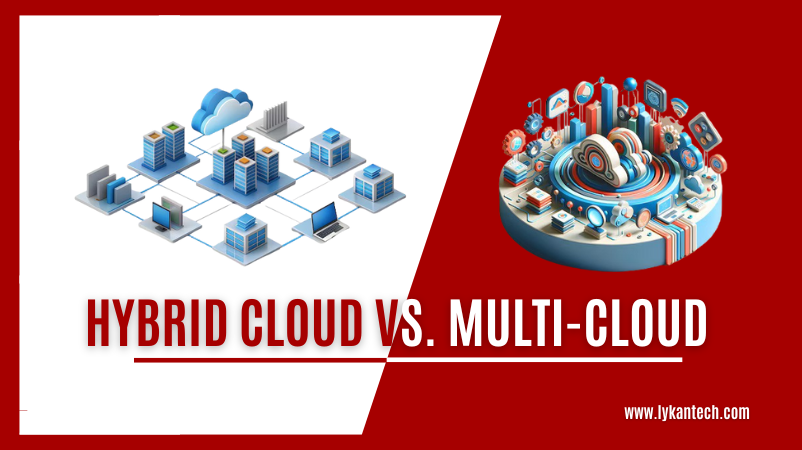Hybrid Cloud vs. Multi-Cloud: A Comprehensive Comparison
In today’s cloud-first world, businesses are rapidly adopting cloud strategies that best fit their unique needs. In this article, we discuss Two of the most commonly used approaches. While both leverage multiple cloud environments, they serve distinct purposes and require different implementation strategies.
This article explores the differences between hybrid and multi-cloud environments, key considerations for designing micro-services in these architectures, and how Lykan Tech empowers businesses to build and manage scalable cloud solutions.
Understanding Hybrid Cloud and Multi-Cloud
What is Hybrid Cloud?
A hybrid cloud strategy combines on-premises infrastructure (private cloud) with public cloud services (such as AWS, Azure, or Google Cloud). This model provides businesses with greater flexibility by allowing workloads to move seamlessly between private and public environments based on performance, security, or compliance requirements.
Key Benefits of Hybrid Cloud:
- Flexibility: Businesses can keep sensitive workloads on-premises while utilizing the public cloud for scalability.
- Cost Optimization: Leverage public cloud resources as needed to reduce infrastructure expenses.
- Security & Compliance: Organizations can meet regulatory requirements by keeping critical data in a private cloud.
What is Multi-Cloud?
A multi-cloud approach involves using multiple public cloud providers (e.g., AWS + Azure + Google Cloud) for different workloads. This model is often adopted to avoid vendor lock-in, optimize performance, or improve disaster recovery.
Key Benefits of Multi-Cloud:
- Avoid Vendor Lock-in – Businesses can select the best cloud provider for each specific workload.
- Improved Redundancy – Ensures high availability and resilience by distributing workloads across multiple providers.
- Optimized Performance – Deploy applications closer to end-users for reduced latency and better performance.
Hybrid Cloud vs. Multi-Cloud: Key Differences
| Feature | Hybrid Cloud | Multi-Cloud |
|---|---|---|
| Infrastructure | Combines private & public cloud | Uses multiple public clouds |
| Workload Placement | Workloads move between private and public clouds | Workloads are distributed across multiple cloud providers |
| Vendor Strategy | Usually tied to one main cloud provider | Avoids dependency on a single cloud provider |
| Security & Compliance | More control over sensitive data | Compliance strategies vary across providers |
| Cost Management | Balances costs between on-prem & cloud | Requires careful cost optimization across providers |
Designing Microservices for Hybrid & Multi-Cloud Architectures
Microservices architecture is the backbone of modern cloud-native applications. When designing microservices for hybrid cloud or multi-cloud, consider the following:
Key Considerations:
- Cloud-Native Design: Use containerization (Docker, Kubernetes) to ensure portability across cloud environments.
- Service Mesh Implementation: Tools like Istio or Linkerd enable secure and scalable microservices communication across clouds.
- API Gateway & Load Balancing: Solutions like Kong, NGINX, or AWS API Gateway help route traffic efficiently.
- Data Synchronization: Implement data replication and consistency mechanisms to ensure seamless operations between environments.
- Security & Compliance: Adopt Zero Trust security models and encryption strategies to secure cross-cloud communications.
How Lykan Tech Helps Businesses Implement Hybrid & Multi-Cloud Strategies
Lykan Tech specializes in designing and managing hybrid cloud and multi-cloud environments tailored to business needs. Our expertise in cloud automation, infrastructure as code (IaC), Kubernetes, and microservices enables organizations to:
- Seamlessly migrate workloads to hybrid or multi-cloud setups.
- Optimize cloud performance and costs through tailored strategies.
- Implement robust security and compliance frameworks for data protection.
- Build scalable microservices that enhance agility and operational efficiency.
Conclusion
Both hybrid cloud and multi-cloud architectures offer significant benefits, but the right choice depends on your business objectives, security needs, and scalability goals. A hybrid cloud is ideal for organizations that require private infrastructure for security compliance, while a multi-cloud approach is best for businesses seeking flexibility and redundancy.
Transform your application architecture with Lykan Tech expertise. Contact us today to build a future-proof cloud strategy tailored to your business needs.

